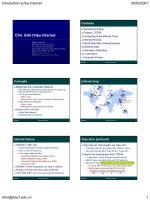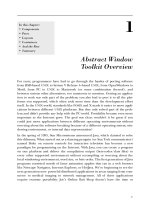Tài liệu Introduction to Requirements – The Critical Details That Make or Break a Project pptx
Bạn đang xem bản rút gọn của tài liệu. Xem và tải ngay bản đầy đủ của tài liệu tại đây (127.77 KB, 9 trang )
Introduction to
Requirements –
The Critical Details
That Make or Break
a Project
1-800-COURSES
www.globalknowledge.com
Expert Reference Series of White Papers
Introduction
Every project an organization undertakes has requirements. It doesn’t matter if it’s building hardware solu-
tions, developing software solutions, installing networks, protecting data, or training users - for the project to
be a success, knowing what the requirements are is an absolute must.
Requirements exist for virtually any components of a project or task. For example, a project may require specif-
ic methods
, expertise levels of personnel,
or the format of deliverables
. This whitepaper will discuss the various
kinds of information technology requirements, their importance, the different requirement types, the concept of
requirements engineering and the process for gathering requirements.
What Are Requirements?
The IEEE Standard 1233-1998, IEEE Guide for Developing System Requirements Specifications, defines a well-
formed requirement as a statement that:
• States system functionality (a Capability)
• Can be validated
• Must be met or possessed by a system
• Solves a customer problem
• Achieves a customer objective
• Is qualified by measurable Conditions and bounded by Constraints
Specifically, a well-formed requirement should contain:
• Capability
• Condition(s)
• Constraint(s)
According to the Oxford American Dictionary:
Capability as a noun is defined as the capability of doing something;
or a power or ability
,
i.e., “the capabili-
ty of bringing the best out in people” or “the capability to increase productivity;” however, when used with an
adjective, a capability describes a facility on a computer for performing specific tasks, i.e., “the computer has a
graphics capability.”
Condition as a noun is defined as the state of something, especially with regard to its appearance, quality, or
working order, i.e., “the wiring is in good condition,” or “the bridge is in an extremely dangerous condition.” A
condition can also be a state of affairs that must exist or be brought about before something else is possible
Richard Frederick, PMP, MCP, MSF Practitioner, IT Portfolio Manager
Introduction to Requirements – The Critical
Details That Make or Break a Project
Copyright ©2007 Global Knowledge T
raining LLC. All rights reserved.
Page 2
o
r permitted, i.e., “for a member to borrow money, three conditions have to be met,” or “all personnel should
comply with this policy as a condition of employment,” or “I'll accept your offer on one condition.”
Constraint as a noun is defined as a limitation or restriction, i.e., “the availability of water is the main con-
straint on food production” or “time constraints make it impossible to do everything.”
Importance of Requirements
The Foundation
Wherever there are people, there are problems.
Different institutions are created to solve these unique, large-scale problems: government, healthcare, trans-
portation, telecommunications, etc. These institutions, utilizing a “systems approach” for planning, organizing,
and controlling resources, initiate projects to focus on “specific objectives” or components of their problems.
Requirements are the documented needs of a project that are gathered to identify the specific constraints
(scope) of each project component and act as the foundation for everything else that occurs in a project.
Project Failure
Requirements are considered by many experts to be the major reason projects do not achieve the triple con
-
straint of “on-time, on-budget, and high quality.” Very few projects do an effective job of identifying and
carrying through the project and all the requirements correctly.
Various studies have shown that failure to meet requirements is the biggest problem in projects. Most defects
occur during the requirements phase. Project teams need to do a much better job on requirements if they wish
to develop quality projects on-time and on-budget.
The Problem
Since the invention of computers
, there have been three primary issues to meeting project requirements
.
First, the technology learning curve is advancing much faster than the business learning curve., In other words,
while technology concepts are changing rapidly, business management concepts have not changed at the
same pace
.
Second, there is a huge disconnect in the language between business people and technology people. Each
group has its own taxonomy (glossary) for how to operate.
T
hird,
because businesses are so reliant on technology
,
it is more important than ever that the two environ
-
ments align together to insure that the systems being built match the requirements of the business needs
.
Alignment
An institution's ability to efficiently align resources and business activities with strategic objectives can mean
the difference between succeeding and just surviving.
The world is cut-throat. To achieve strategic alignment, institutions are “projectizing” their business to monitor
performance more closely and make better business decisions about their overall work portfolio.
Copyright ©2007 Global Knowledge T
raining LLC. All rights reserved.
Page 3
Governance
Because of errors and omissions on the part of institutions in the public trust, (e.g., government agencies and
publicly held corporations) the U.S. Congress has passed legislation to require transparency throughout organi-
zations to eliminate opportunities for fraud.
Transparency is the ability of an institutions governing body to see through the organization. The way to see
through an organization is by documenting – creating a paper-trail – of all the transactions that occur. Today,
institutions utilize their information systems and IT departments to insure that the electronic paper-trail exists
and is working correctly.
The costs of non-compliance are very large and can include incarceration for the institution’s executives.
However, the benefits to be derived from transparency should be the dream of every executive; transparency
will bring about the ultimate goal of executives having access to “any data, on any part of the business, from
anywhere, and at any time.”
Re-Work
Due to the “time value of money,” all institutions must put their financial resources to work. If there are errors
in requirements, they increase the need for re-work and decrease an institution’s operational efficiency. This
works against every institution’s goal of managing for value.
Therefore, the earlier requirements problems are found, the less expensive they are to fix. The best time to fix
them is when you are involved in gathering, understanding, and documenting them with your stakeholders
(who should be the source of your project requirements).
The Challenge
The requirements phase is considered by many experts to be the most difficult part of any project. The hardest
requirements problems to fix are those that are omitted.
This really becomes the requirements analyst's dilemma. The analyst often does not know what questions to
ask, and the stakeholder does not know what information the analyst needs. Since the analyst doesn't ask, the
stakeholder doesn't state requirements.
Types of Requirements
Business Objectives
T
he overall business goals and guidelines for the project are called business objectives
.
Business objectives
help provide the foundation for a project and are obtained normally from management or from existing com-
pany documents.
For example: Company XYZ will increase sales domestically by 50 percent within two years.
Business Requirements
Requirements from stakeholders are called business requirements. These requirements can include business
processes the system needs to support;
v
arious constraints such as cost,
resources
,
schedule;
and more.
Copyright ©2007 Global Knowledge T
raining LLC. All rights reserved.
Page 4
B
usiness requirements often come from managers, although workflow processes (how people do their jobs or
should do their job, if you are trying to optimize business processes) will probably come from those actually
doing the work or end-users of the system.
Stakeholder Requirements
A stakeholder is anyone with a vested or substantive interest in the project. Stakeholder requirements include
the needs of stakeholders both internal and external to the organization. The challenge of any project is to
accurately identify all of the stakeholders, and to elicit and understand their needs.
End-User Requirements
Needs from those who will directly or indirectly interact with the system are called end-user requirements.
These include requirements for the documentation and user interface, which can be very complex and are
often a source of error.
System Requirements
System requirements come from analyzing the business objectives and stak
eholder requirements. While busi-
ness objectives and stakeholder requirements are written in business terms and are from a real-world
perspective, system requirements are more rigorous, more formal, and are written in systems (technical) termi-
nology.
For example, a stakeholder requirement might refer to “Company XYZ Monthly Sales Report,” while a system
requirement might refer to that same thing as “XYZMoSalesRept.doc.”
System requirements are high-level requirements for an entire system. Systems may include subsystems (for
example, hardware subsystem, operating subsystem, software subsystem [or subsystems], or network subsystem).
Software Requirements
Software requirements, such as the functionality necessary for operating within a harsh physical environment
or the graphical user interface needed between the user and the machine
, are detailed, specific requirements
written for a software system (or subsystem).
Requirements Engineering
According to the IEEE Software Engineering Body of Knowledge® (SWEBOK®), requirements engineering
includes four processes: elicitation, analysis, specification, and validation.
Elicitation
Requirements elicitation is concerned with where project requirements come from and how the analyst can
collect them. It is the first stage in building an understanding of the problem the project is required to solve. It
is fundamentally a human activity, and is where the stakeholders are identified and relationships established
between the project team and the customer. It is variously termed “requirements capture,” “requirements dis-
covery,” and “requirements acquisition.”
One of the fundamental tenets of good project management is that there be good communication between
users and the engineers. Before development begins, requirements specialists may form the conduit for this
communication.
They must mediate between the business domain of the users (and other stakeholders) and
the technical world of the engineers.
Copyright ©2007 Global Knowledge T
raining LLC. All rights reserved.
Page 5









